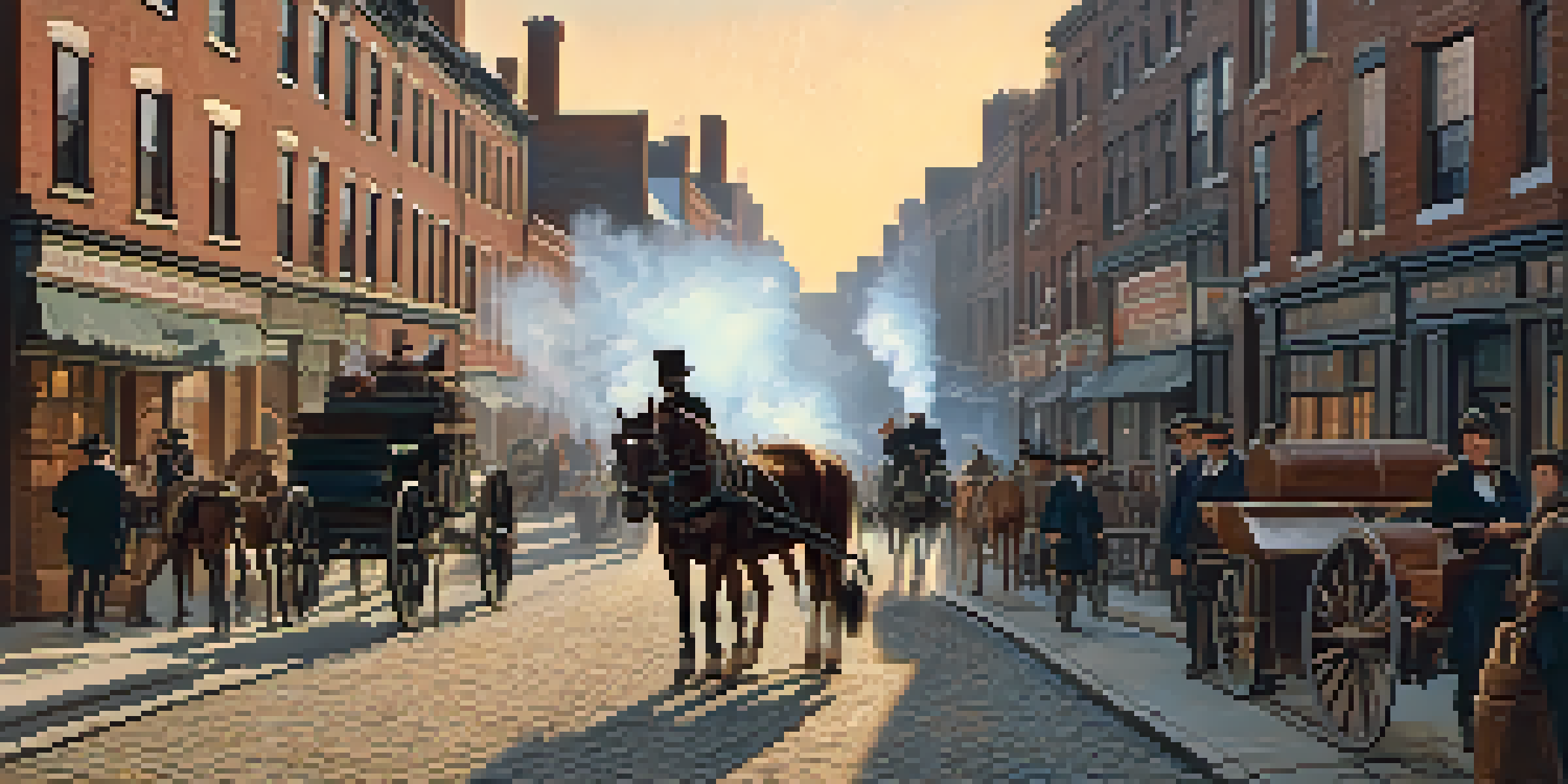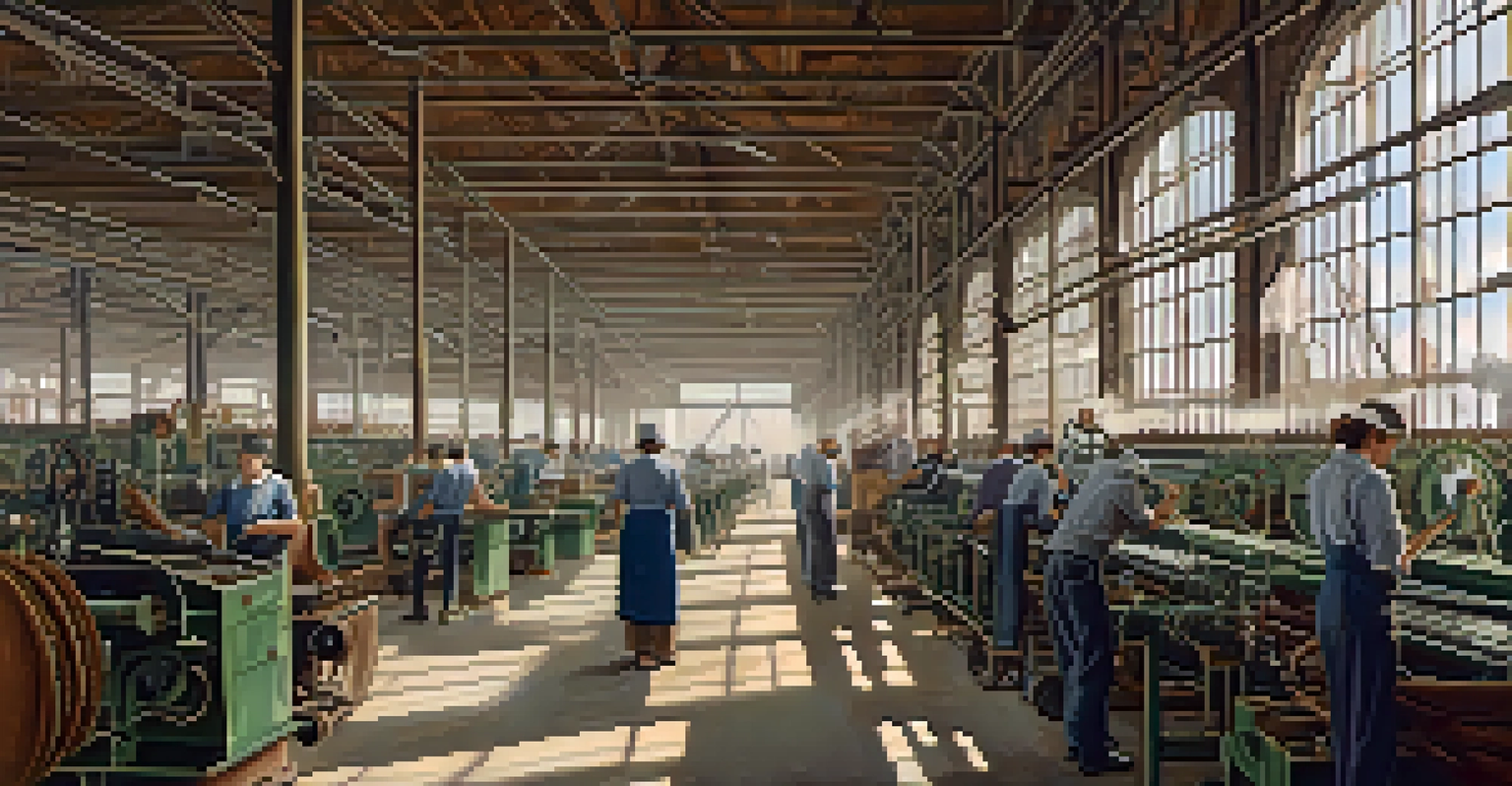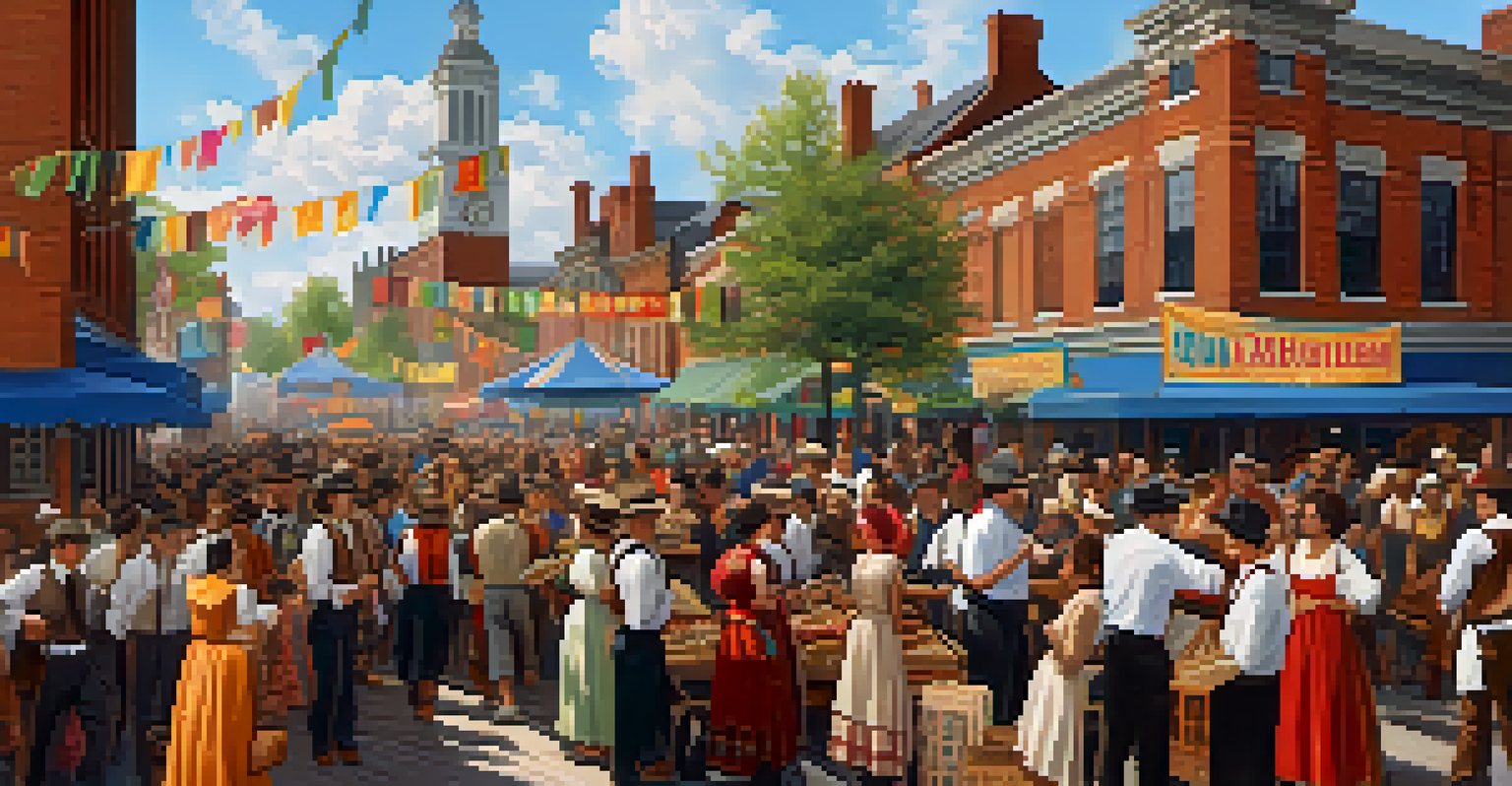Industrial Revolution: Newark's Transformation

The Dawn of the Industrial Revolution in Newark
The Industrial Revolution marked a pivotal shift in Newark, transforming it from a quaint settlement into a bustling hub of industry. This change began in the late 18th century, as technological advancements revolutionized manufacturing processes. Factories sprang up, drawing laborers from rural areas to the city, eager for work and opportunity.
The Industrial Revolution was another of those extraordinary jumps forward in the story of civilization.
As innovations such as the steam engine and mechanized looms became prevalent, Newark quickly embraced these new technologies. The city’s strategic location along transportation routes further accelerated its growth, enabling goods to be shipped efficiently. This influx of industry not only changed the skyline but also the very fabric of the community.
The rising industrial landscape prompted a population boom, as people flocked to Newark seeking employment. This migration brought diverse cultures and ideas, enriching the city’s social tapestry. However, it also posed challenges, including overcrowded living conditions and the need for improved infrastructure.
Key Industries That Shaped Newark's Economy
Throughout the Industrial Revolution, several key industries emerged as the backbone of Newark’s economy. Manufacturing, particularly in textiles and leather goods, became a significant source of employment. Newark’s factories produced everything from shoes to garments, establishing the city as a leader in these sectors.

The rise of the railroad further enhanced Newark's status, allowing for the quick transportation of raw materials and finished products. This connectivity not only facilitated trade but also attracted new businesses to the area. As a result, Newark became known for its vibrant industrial sector, which played a crucial role in the nation’s economy.
Newark's Industrial Transformation
The Industrial Revolution fundamentally changed Newark from a small settlement into a thriving industrial center, attracting workers and innovations.
In addition to textiles and leather, the city also saw growth in industries like pharmaceuticals and machinery. These businesses not only provided jobs but also contributed to technological advancements, making Newark a center of innovation. This diverse economic landscape laid the groundwork for future growth and development.
The Social Impact of Industrialization in Newark
As factories multiplied, Newark underwent significant social changes, affecting the lives of its residents. The influx of workers led to the emergence of new neighborhoods, often characterized by tight-knit communities. However, this rapid growth also resulted in challenges such as poor living conditions and limited access to basic services.
Immigration is the mother of all innovation.
Labor unions began to form in response to the harsh realities of factory life, advocating for better wages and working conditions. Workers rallied together, demanding rights and protections that would lay the foundation for future labor reforms. This collective action not only empowered individuals but also fostered a sense of solidarity among the workforce.
Furthermore, the Industrial Revolution catalyzed a cultural shift in Newark. With new ideas and diverse backgrounds converging, the city became a melting pot of traditions and values. This cultural richness contributed to a vibrant arts scene and community events, illustrating that industrial growth could coexist with social and cultural development.
Urbanization and Its Challenges in Newark
The rapid urbanization that accompanied industrial growth brought about both opportunities and challenges for Newark. As more people settled in the city, the demand for housing surged, leading to the construction of tenement buildings. These cramped living conditions often lacked basic amenities, highlighting the disparity between wealth and poverty.
Infrastructure struggled to keep pace with the burgeoning population, resulting in overcrowded streets and inadequate public services. Transportation, sanitation, and education systems faced immense pressure, prompting city officials to seek solutions. The challenges of urban life forced Newark to adapt, setting the stage for future urban planning initiatives.
Diverse Cultures Shaped Newark
The influx of immigrants during this period enriched Newark's cultural landscape, contributing to its economic growth and vibrant community.
Despite these difficulties, urbanization also spurred innovation. Entrepreneurs sought to address the needs of a growing population, leading to the development of new businesses and services. This entrepreneurial spirit contributed to Newark’s resilience, proving that even amidst challenges, there was room for growth and improvement.
The Role of Immigrants in Newark's Industrial Growth
Immigrants played a crucial role in Newark's transformation during the Industrial Revolution. Many arrived seeking better economic opportunities, filling the labor shortages in factories and construction. They brought diverse skills, cultures, and traditions, enriching the city and shaping its identity.
These new residents often faced hardships, including language barriers and discrimination. Yet, their determination to succeed fueled Newark's industrial growth. As they settled in the city, they contributed to the workforce and established businesses, becoming an integral part of Newark's economic landscape.
The immigrant experience in Newark is a testament to the city’s resilience and adaptability. Communities formed around shared backgrounds, fostering support networks that helped newcomers navigate their new lives. This cultural integration not only bolstered the economy but also laid the foundation for Newark's rich, diverse heritage.
Technological Innovations That Transformed Newark
Technological innovations during the Industrial Revolution had a profound impact on Newark's industries. The introduction of machinery into manufacturing processes increased efficiency and productivity, allowing factories to produce goods at an unprecedented scale. This shift not only transformed the economy but also changed the way people worked.
The rise of the assembly line further revolutionized production in Newark. Factories adopted this method to streamline workflows, reducing the time it took to create products. This innovation not only improved output but also helped establish Newark as a center of industrial efficiency.
Technological Advancements Boosted Growth
Innovations in manufacturing and transportation during the Industrial Revolution significantly enhanced Newark's productivity and connectivity.
Moreover, advancements in communication and transportation technology played a vital role in Newark's growth. The telegraph and telephone improved business operations, while the expansion of railroads connected the city to larger markets. These innovations made Newark an integral part of the national economy, showcasing the transformative power of technology during this era.
Legacy of the Industrial Revolution in Newark Today
The legacy of the Industrial Revolution continues to shape Newark today, influencing its economy and culture. Many historic factories have been repurposed, becoming hubs for innovation and creativity in the modern age. This adaptive reuse reflects the city’s ability to evolve while honoring its industrial heritage.
Moreover, the diverse population that emerged during the Industrial Revolution remains a defining characteristic of Newark. Cultural festivals, culinary diversity, and artistic expressions reflect the rich tapestry of communities that have called Newark home. This vibrant culture fosters a sense of belonging and pride among residents.

As Newark navigates the challenges of the 21st century, the lessons learned from its industrial past remain relevant. The city's commitment to innovation and resilience serves as a guiding principle for future development. Ultimately, Newark's transformation during the Industrial Revolution laid the groundwork for its ongoing evolution and growth.